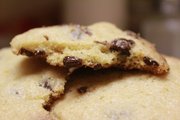The first rule of baking club is ... you don't talk about Baking Club. The second rule of baking club is ... you don't talk about Baking Club.
Seriously, if you have your whisk and apron and want to join the club, you have to know the rules to break the rules.
Fight Club references aside, what are the rules of Baking Club? For me, the No. 1 rule is: don't change the recipe if you don't understand the chemistry. I've done this before, as I'm sure a lot of other people have. Sometimes it works, and you hit a gold mine, but nine times out of 10 it doesn't, and you're left with a gooey or burnt mess on your hands.
The best way to learn the rules is to start simple—maybe with chocolate-chip cookies. Because of how easy they are, chocolate-chip cookies are my favorite to bake. And I'm basically the human form of Cookie Monster, so they're also my favorite to eat.
Where to start? You can find so many different variations of chocolate-chip cookies, with ingredients such as cinnamon and caramel added, but to understand how the process works, your best bet is to start with a basic cookie recipe.
Chocolate Chip Cookies
Ingredients
2 1/4 cups all-purpose flour
1 teaspoon salt
1/2 teaspoon baking soda
1/2 teaspoon baking powder
1 cup room-temperature unsalted butter (about two standard-size sticks)
3/4 cup brown sugar
3/4 cup granulated sugar
2 large eggs
1 teaspoon vanilla extract
1 cup chocolate chips
Directions
Preheat the oven to 350 degrees. Combine the flour, salt, baking soda and baking powder into a medium-size mixing bowl and stir the ingredients together.
If you've ever made chocolate-chip cookies before, you might notice that something is off. I said to use baking powder and soda. Why, you ask? I got this tip from Tessa at Handle the Heat. In her experiment on the cookies, she used baking soda and powder for one of her batches, and to her, they seemed to work the best out of all the ingredient combinations so I decided to try it for myself.
Why are these two ingredients so important? For the answer, you have to look at the chemistry of each item. Baking soda, or sodium bicarbonate, is a leavening agent that produces a carbon-dioxide gas when combined with an acid. Baking powder, unlike soda, reacts in two different ways—the ingredient, which is a combination of baking soda, powdered acid and cornstarch, releases CO2 while you're mixing and when the food is cooking. Baking soda needs an acid, and baking powder contains acid. When baking chocolate-chip cookies, it's also important to remember that baking soda aids in the browning people enjoy so much.
Cream together the butter and sugar. You see a lot of this in cookie recipes. Creaming allows the sugar to be incorporated into the butter and also lets some air into the recipe, which makes cookies fluffier.
But why is it important to use room-temperature butter? Sugar digs little holes into the butter to aerate it. If the butter is cold or hot, the sugar can't do anything.
You also have to consider the sugar when baking anything. For a long time, I thought of the ingredient as merely a way to sweeten things. I was under the assumption that if I used a substitute, the baked good would end up the same. This is completely wrong—the sugar is one of the keys to baking reactions. When the sugar aerates your room-temperature butter, it sets the stage for rising. Baking soda and powder magnifies the air pockets, and bam. Your cookies are rising in the oven.
Sugar also attracts moisture, which lessens the amount of gluten the flour produces while baking. (This doesn't mean that your cookies will be gluten-free. It just means that the cookies will be more moist.)
So why use both brown sugar and white sugar? They're made from the same plant, so what's the big deal? White sugar is generally refined sugar with the molasses and everything taken out. Brown sugar is white sugar that has had the molasses added back in. It's got a rich butterscotch flavor that adds more depth of flavor to the cookies.
The amount of molasses determines how dark or light the sugar is. If you take out the white sugar and replace it with more brown, you will get a more butterscotch-esque flavor in your cookies.
Mix in the eggs and vanilla extract.
This isn't particularly confusing, except for one simple rule people may not follow or be aware of: Mix your eggs in one at a time. This creates a more even batter.
Incorporate the dry ingredients slowly.
I always mix about a fourth or a half in at a time, depending on how much time I actually have to finish the cookies. Again, this is all about mixing the batter evenly. Be careful, though, because you could over-mix the dough.
Fold in the chocolate chips.
You never want to use a hand mixer to stir in your chocolate chips. This, too, causes over-mixing. Pour in the chips and, using a rubber spatula, gently fold over different parts of the dough to incorporate them evenly.
Scoop the dough out half a tablespoon at a time onto parchment paper or buttered pan. Place each about an inch apart and bake in the oven for about 15 minutes.




Comments
Use the comment form below to begin a discussion about this content.
comments powered by Disqus